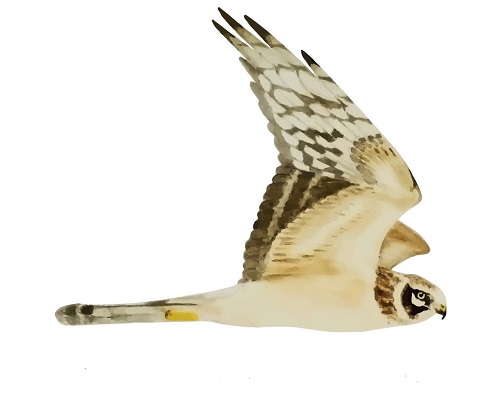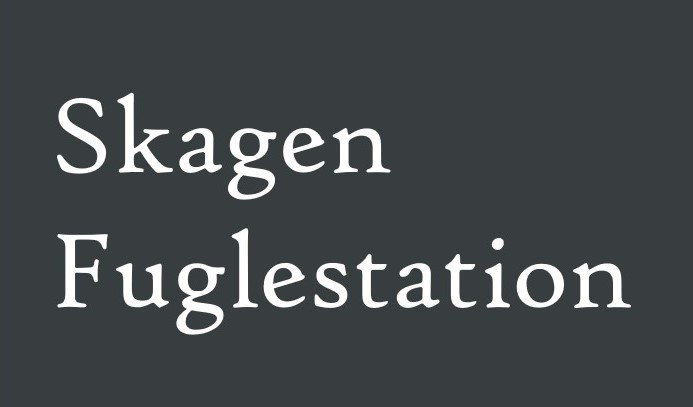Her på Skagen Fuglestations blog bringes korte nyheder i dagbogsformat om hændelser på fuglestationen.
Se indlæg fra måned: jan. (2)feb. (3)mar. (31)apr. (30)maj (31)juni (30)juli (31)aug. (31)sept. (30)okt. (31)nov. (30)dec. (9)
First snowfall
The day started rainy, and at some point even the first snow fell, so we could sleep an hour longer than usual and went to observing and ringing after it stopped. I and Florian went to Northstrand for the migration count because there is a place where you are a bit more sheltered. We had a good start with many Auks, the highlight being 3 Little Auks (Søkonge) and 3 Smews (Lille Skallesluger), which are a rather uncommon sight here in Skagen. At the end, we managed to count for more than three hours despite the late start.
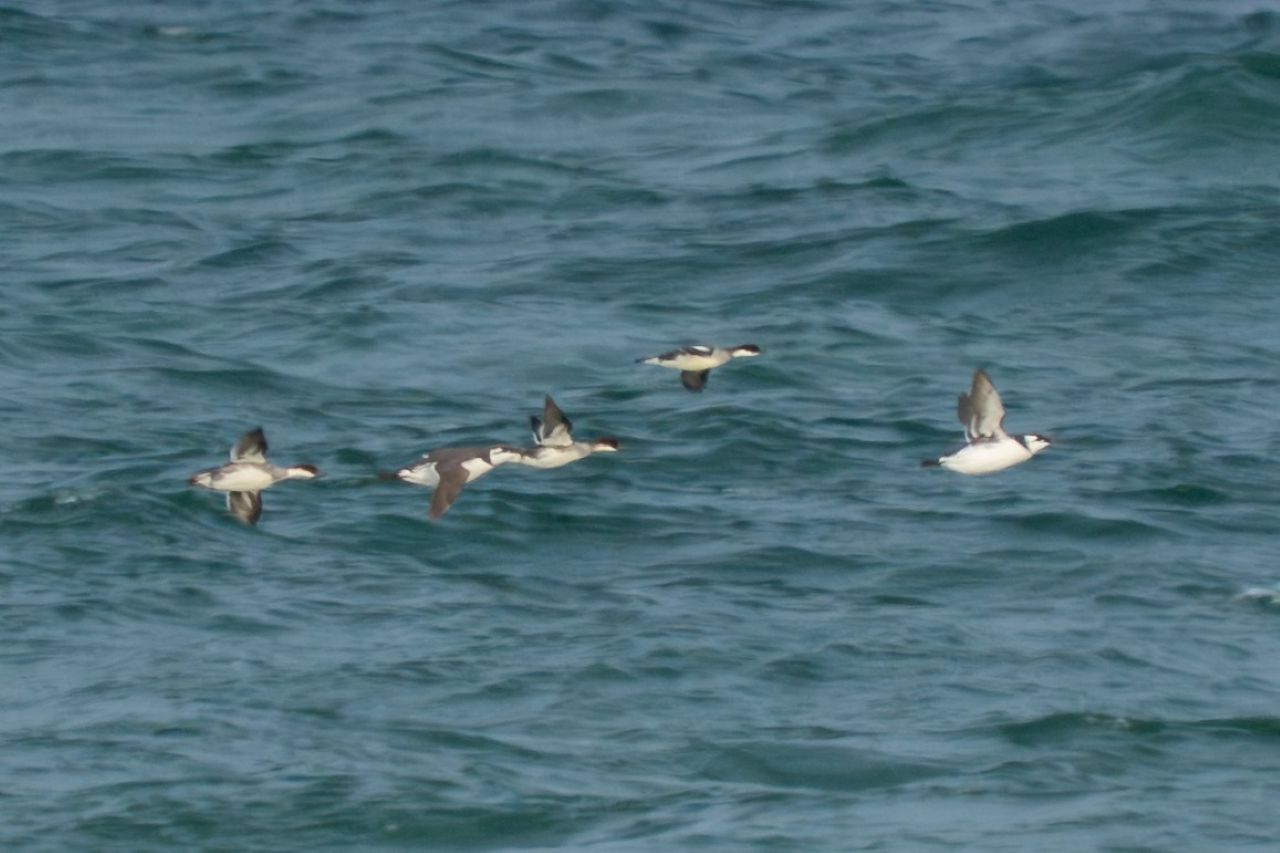
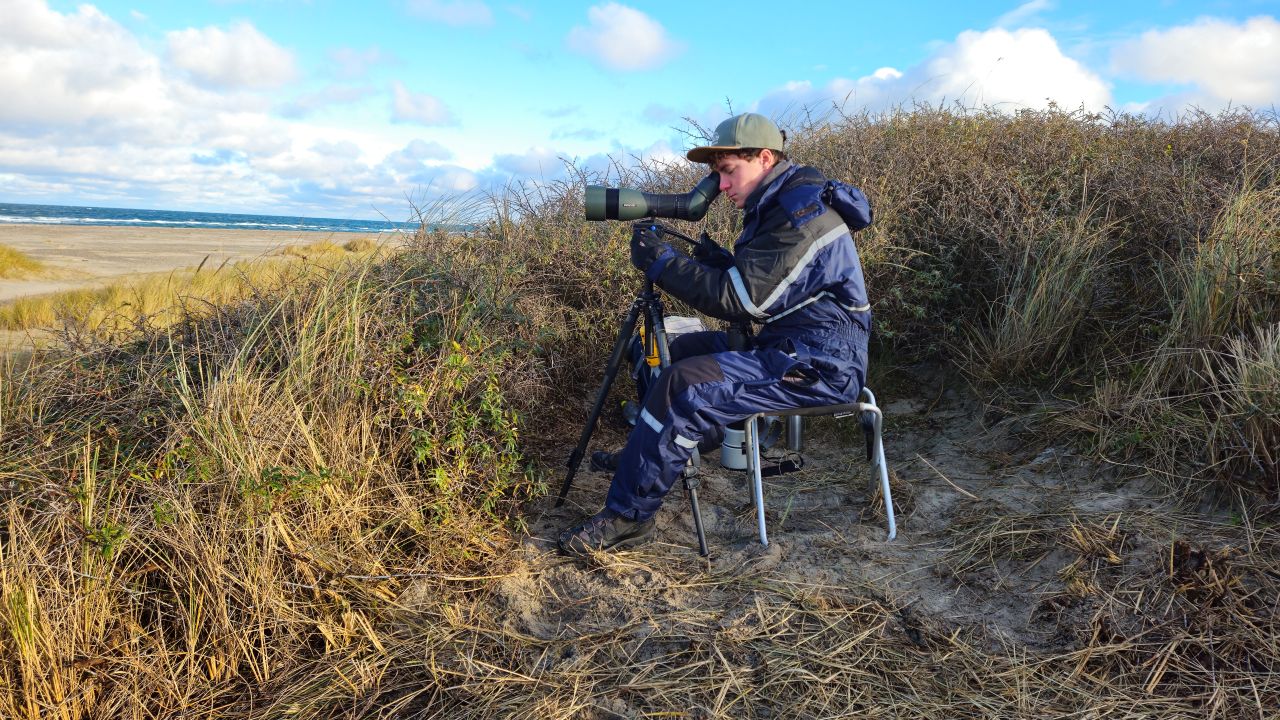

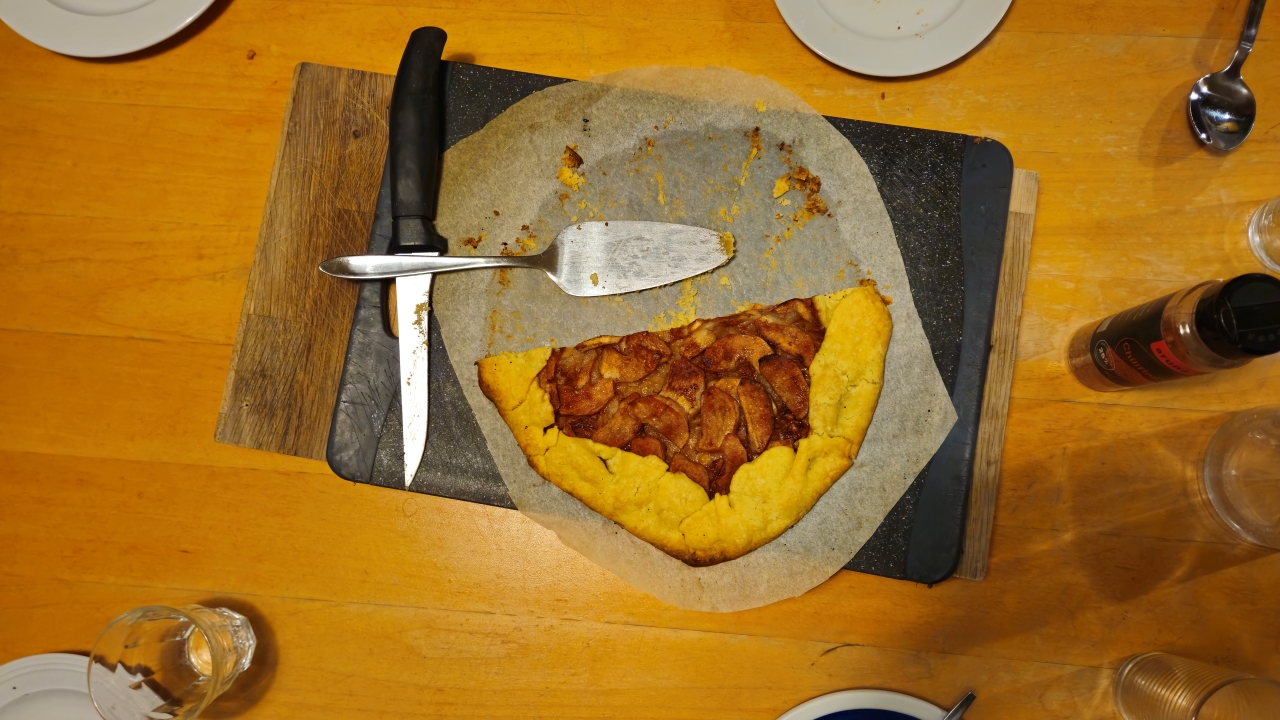
Skægmejse 1
Dompap 1
Total new birds: 2
Link to today’s observations from the area.
People: Miles Scheuering, János Schadl, Florian Hatt, Amira Nuseibeh, Lise Mastrup and Mathilde Lundt Larsen
Birding and a Birthday
I had decided to go ringing today, as the ringing season is slowly coming to an end. So I wanted to take advantage of one of these last chances. It was very nice of János and Amira to go out early to open the nets. That meant I could sleep a little longer. As a result, I was still at home when Lise came in for breakfast and discovered the card we had written for her. Because today was her birthday! Happy birthday, Lise!!! As an activity for the morning, she had chosen the migration count, where she went with Mathilde, Miles and Knud. In general, it wasn't super busy, but there were still some nice birthday species. A Black-throated Diver (Sortstrubet Lom) and a Long-tailed Duck (Havlit) were nice to see, as well as three Little Auks (Søkonge)! Also worth mentioning, of course, are a good number of Light-bellied Brent Geese (Lysbuget Knortegås) and a Red-necked Grebe (Gråstrubet Lappedykker)! It was still cold, but as the wind wasn't so strong, it was still comfortable without a boiler suit. However, those who had one with them enjoyed a particularly cozy migration count today.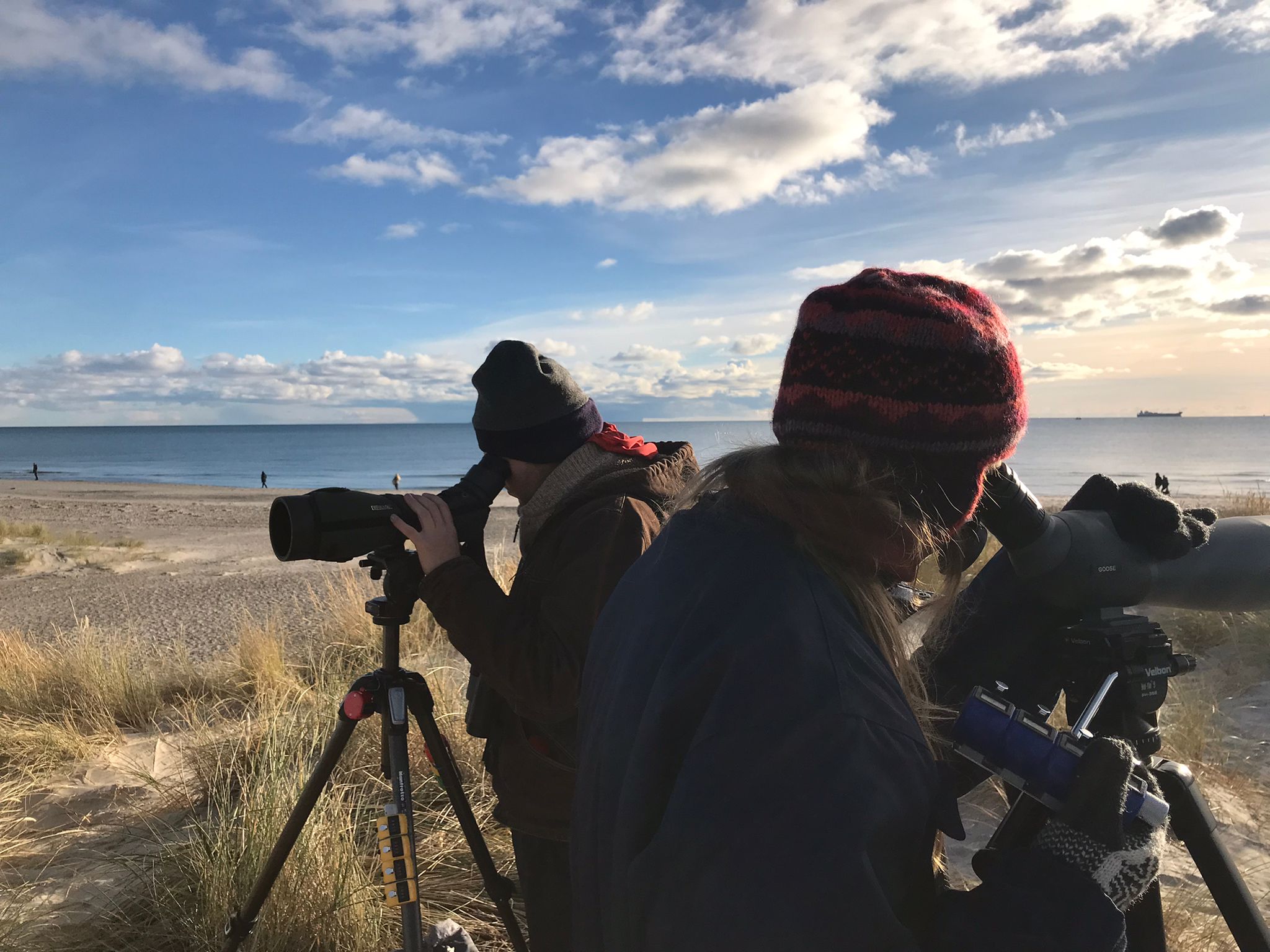
Professional bird counters
At the same time, a relaxed morning of bird ringing took place but still with a good number of birds. Interestingly, over half of all caught birds were recaptures. It was great for me to see a Redwing (Vindrossel) up close and extract a Dunnock (Jernspurv) from the net, which are getting scarce in ringing here.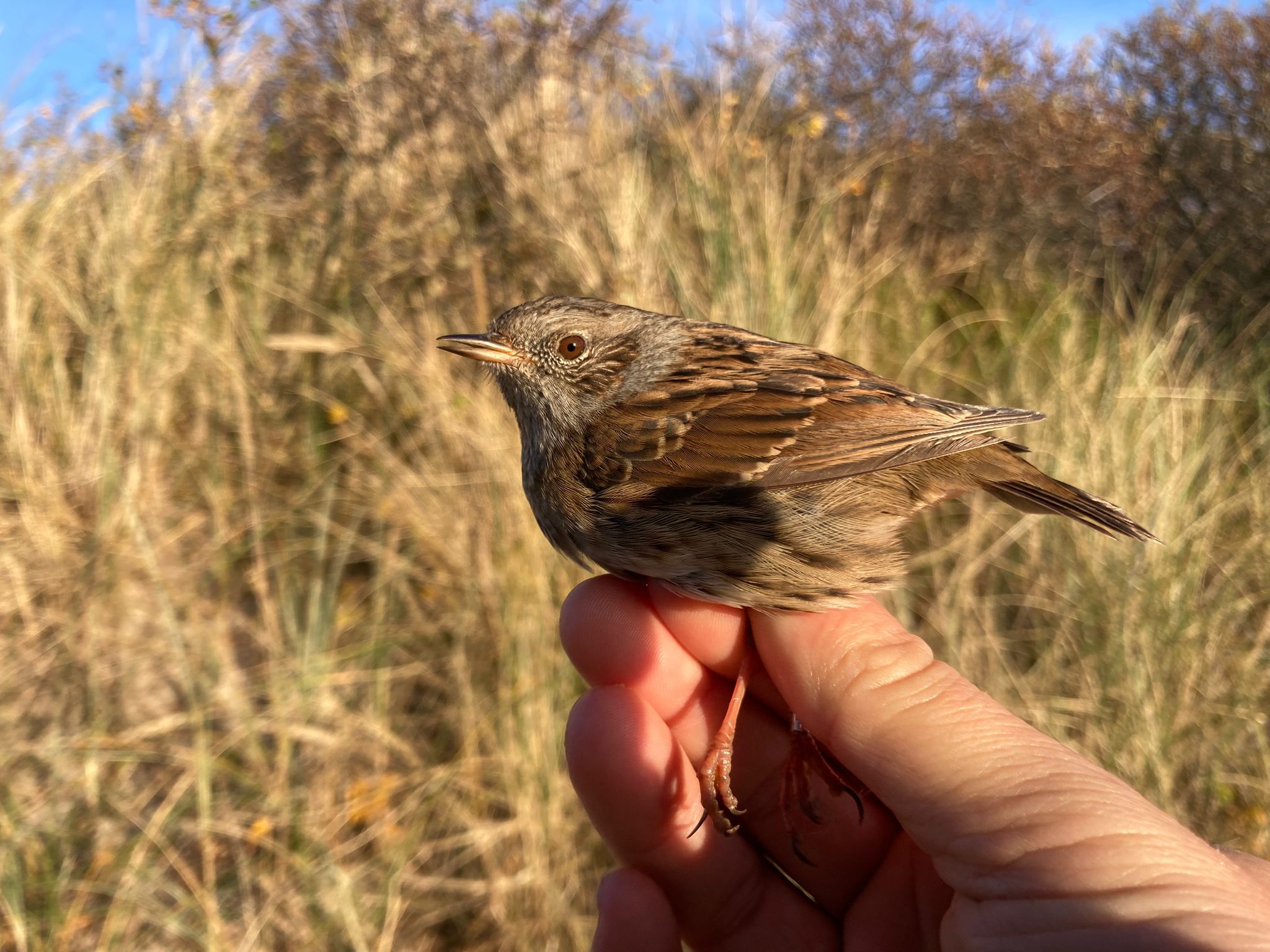
Dunnock (Jernspurv)
When Amira announced that she had a Reed Bunting (Rørspurv) in a bag, János and I joked that it must be a Black-faced Bunting (Gråhovedet Værling). So the suspense increased until Amira actually took a Reed Bunting (Rørspurv) out of the bag. This was of course also a highlight of the day and it had been quite a long time since the last one had appeared in the nets here. Once again, a Firecrest (Rødtoppet Fuglekonge) appeared, yet another recapture. But it wasn't just the birds we caught that were the highlights today, but also a flock of Water Pitpits (Bjergpiber) flying overhead and Woodlark (Hedelærke)! The company was also quite good as Lise and Mathilde came by to help for one round after the obs and even Simon showed up for a while, despite having to cycle to Kabeltromlen as his car was in for repairs. Unfortunately, we forgot the banana chips we had promised him here.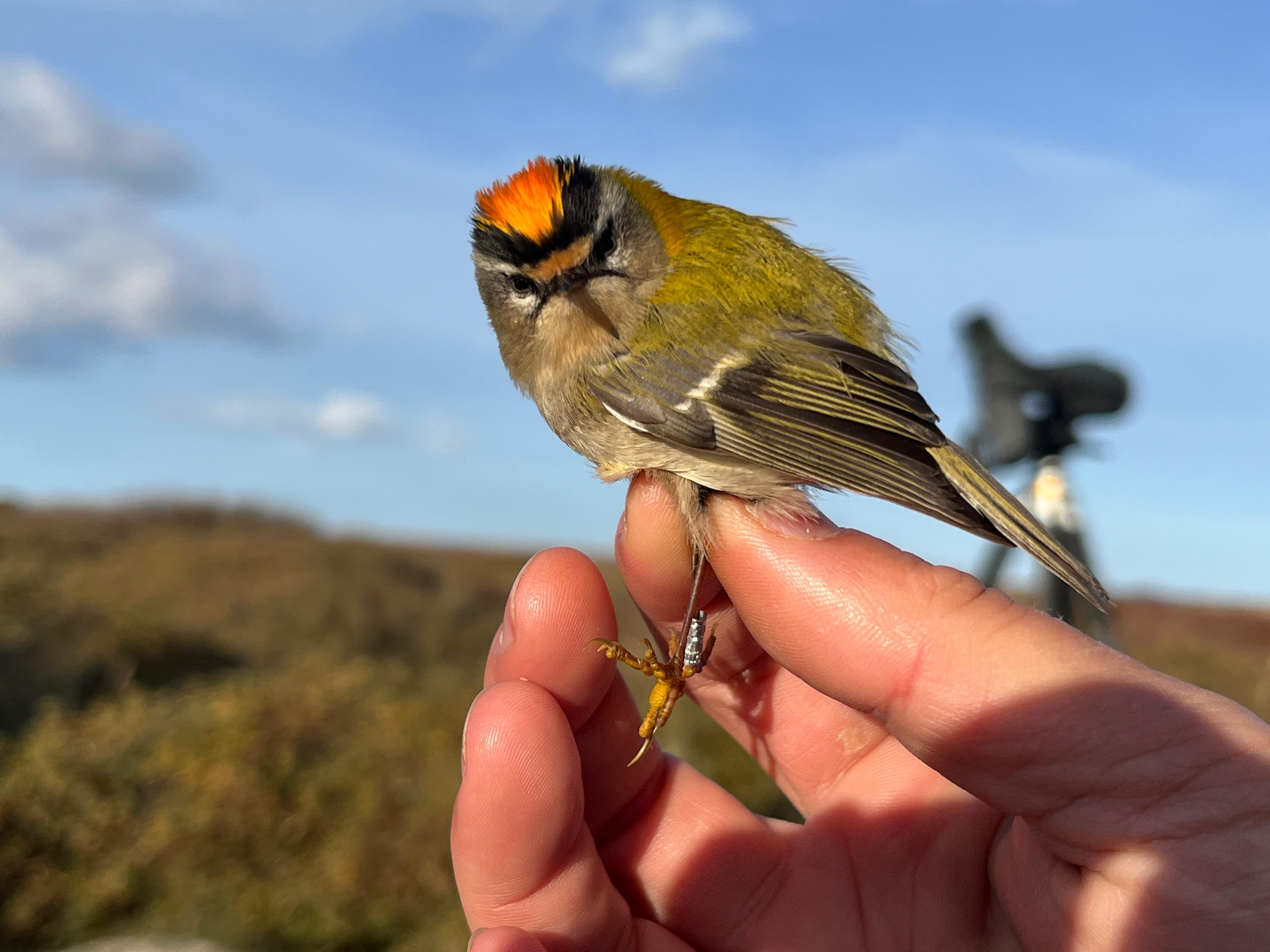
Fresh hairstyle of a Firecrest (Rødtoppet Fuglekonge)
When the ringing was finished, I stayed outside to make the most of the last two hours of daylight. I was hoping to photograph Sanderlings (Sandløber) in the evening sun, but the sun disappeared behind some clouds before the light got really good. The atmosphere was still great and on the way back I even saw a Goshawk (Duehøg), so this was a nice evening trip.
In the meantime, Mathilde and Lise had baked for all of us a banana cake! It was so good! After a delicious dinner (with lots of olives) prepared by Amira, everyone could even have a second piece of the cake :)
Solsort 4
Grønirisk 3
Gærdesmutte 2
Rødhals 1
Dompap, Stor (pyrrhula) 2
Rørspurv 1
Blåmejse 3
Bogfinke 1
Munk 1
Fuglekonge 1
Total new birds: 20
(+ 21 recaptures)
Link to today’s observations from the area.
People: Miles Scheuering, János Schadl, Florian Hatt, Amira Nuseibeh, Lise Mastrup, Simon S. Christiansen, Michael Ancher, and Mathilde Lundt Larsen
Cold, northern winds
This morning it still seemed a bit too windy to ring, but Amira went out to Kabeltromlen anyway to check. She was only able to open a handful of nets, and after a little waiting to see if the wind would relent, closed them again and joined the rest of us at Worlds End 3. The wind created several obstacles for us observers, the first being it was out of the north and quite cold and we only had two boiler suits, and the second was it created a lot of blowing sand. This meant that we could not look directly into the wind, at the risk of scratching the scope lenses. Despite this, there were several good birds, including a Great Northern Diver aka Common Loon (Islom), a Little Auk aka Dovekie (Søkonge), and a (relatively) close Northern Fulmar (Mallemuk). There were also good numbers of Black-legged Kittiwakes (Ride), with some flying over the beach and very close to us!
I was managing the cold alright, but when Amira mentioned that some of us could leave to do the fulmar walk to Gammel Skagen, I was quite excited. We left Florian, János, and Lise to finish the count while we went back to the lighthouse to collect bags, before beginning the walk. We walked back to Grenen along the beach and all the way out to the tip (I think it’s actually the first time I have been all the way to the end, despite the countless hours I have stared at it) before following the shore to the west. We did not see so many birds, alive or dead, and none of the dead birds were in good enough condition to collect, but it was still a beautiful, sunny day to be out on a walk.
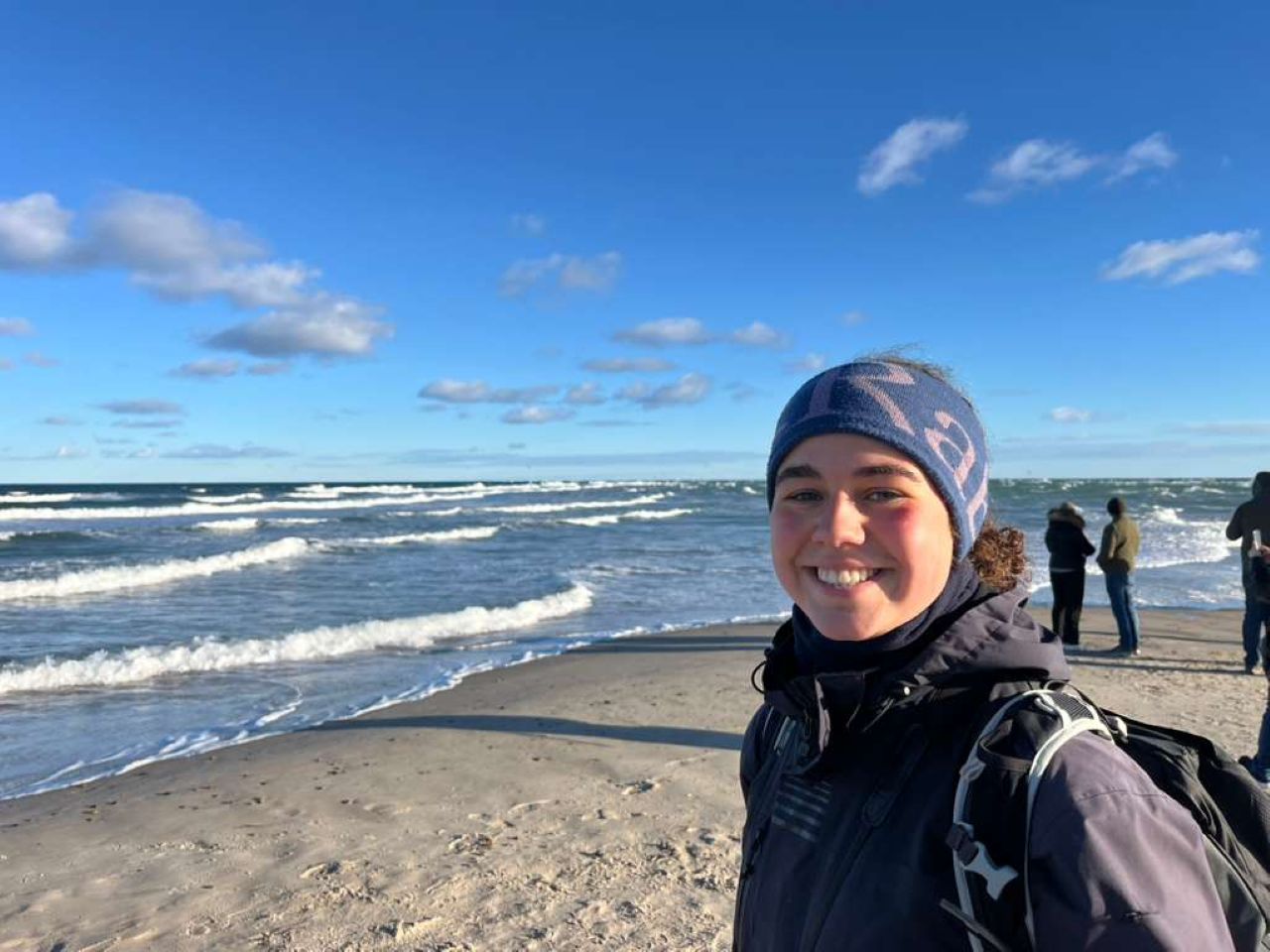
Amira at the tip of Grenen during the fulmar walk. Photo by Miles
Simon picked us up from Gammel Skagen and brought us back to the lighthouse. Along the way, we stopped at Knud’s house to pick up some apples, which we plan to use in the coming days to attract Bohemian Waxwings (Silkehale) to the net we have in the garden. When we were there, Knud and his wife kindly invited us in for coffee with them and their friends, who Simon also knew.
After finishing the migration count, the observers ate lunch and then dispersed for their various “duties.” Florian went birding by the sewage plant and elsewhere in the industrial area, before joining János for some gull watching in the harbor (truly a tour of the best scenery Skagen has to offer). They did not see as many gulls as yesterday but did see several Caspian Gulls (Kaspisk Måge). They also stocked up on toast bread, in preparation for gulling in the coming days now that the temperature has dropped. Lise took care of some errands before picking up her girlfriend Mathilde, who we are excited to have visiting the station this week.
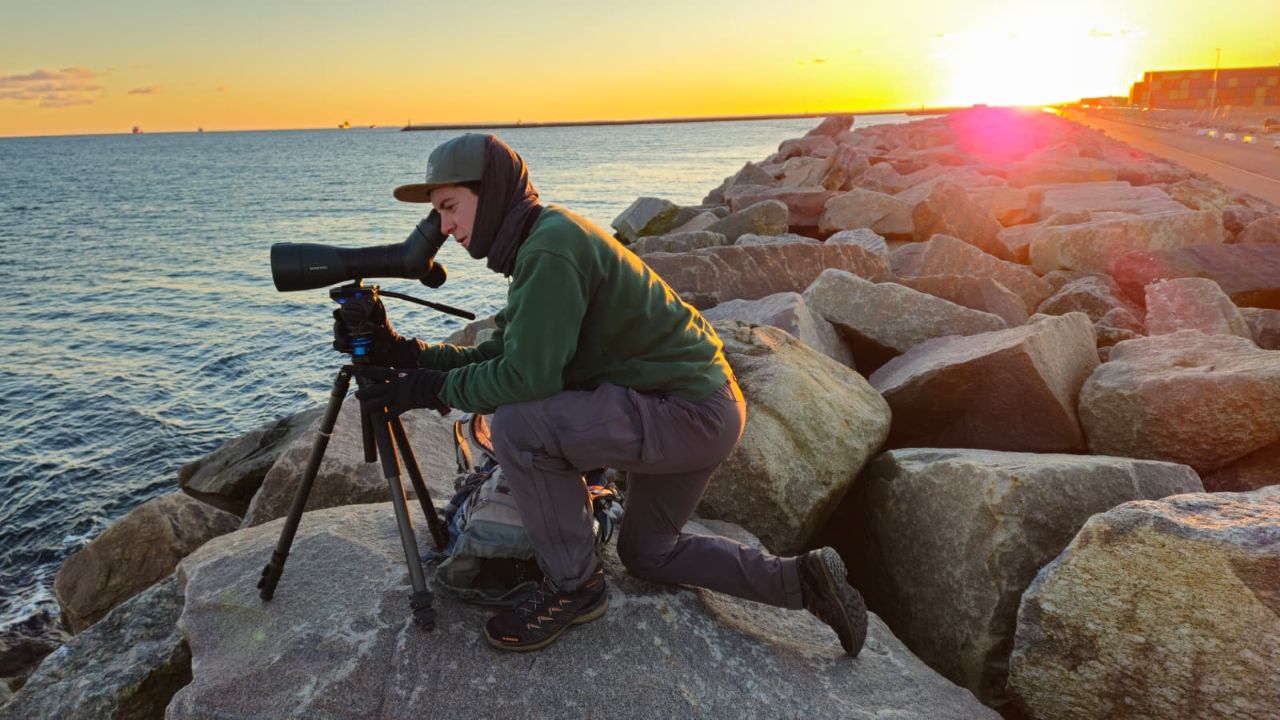
Florian gull watching at the harbor. Photo by János
This evening, János cooked us a delicious curry for dinner, before we finished up the last of the Listers documentary. We all quite enjoyed it, and it was especially fun for me, because I am familiar with many of the places, birds, and people featured in it. Tomorrow is Lise’s birthday, so hopefully the day will be filled with good birds and merriment!
No ringing at Kabeltromlen
Link to today’s observations from the area.
People: Miles Scheuering, János Schadl, Florian Hatt, Amira Nuseibeh, Lise Mastrup, Simon S. Christiansen, Michael Ancher, and Mathilde Lundt Larsen
Cool birds, Coffee, and Chilly Counting
Today was another really lovely day of birdwatching in Skagen. The day started off quite windy, but Miles and I still cycled to Kabeltromlen to check if we could open any of the nets. We tried our best but eventually decided it wasn’t safe enough to ring and packed up soon after sunrise (which was really beautiful today!). I went straight to join the observers at World’s End 3 for the rest of the morning where there was quite a crowd of people today.
Overall, it was a slow migration day, but there were still some great highlights including two very late Sandwich Terns (Splitterne) and a Red Knot (Islandsk Ryle), which we haven’t seen in a while. A Little Auk (Søkonge) in the first hour is always a treat, and it was also very cool to see a Woodcock (Skovsneppe) appear out of nowhere in front of us! In the first hour, we also had a higher than usual number of Kittiwakes (Ride), over 150, and it's nice that flocks of Red Throated Divers (Rødstrubet Lom) are becoming a regular sight.
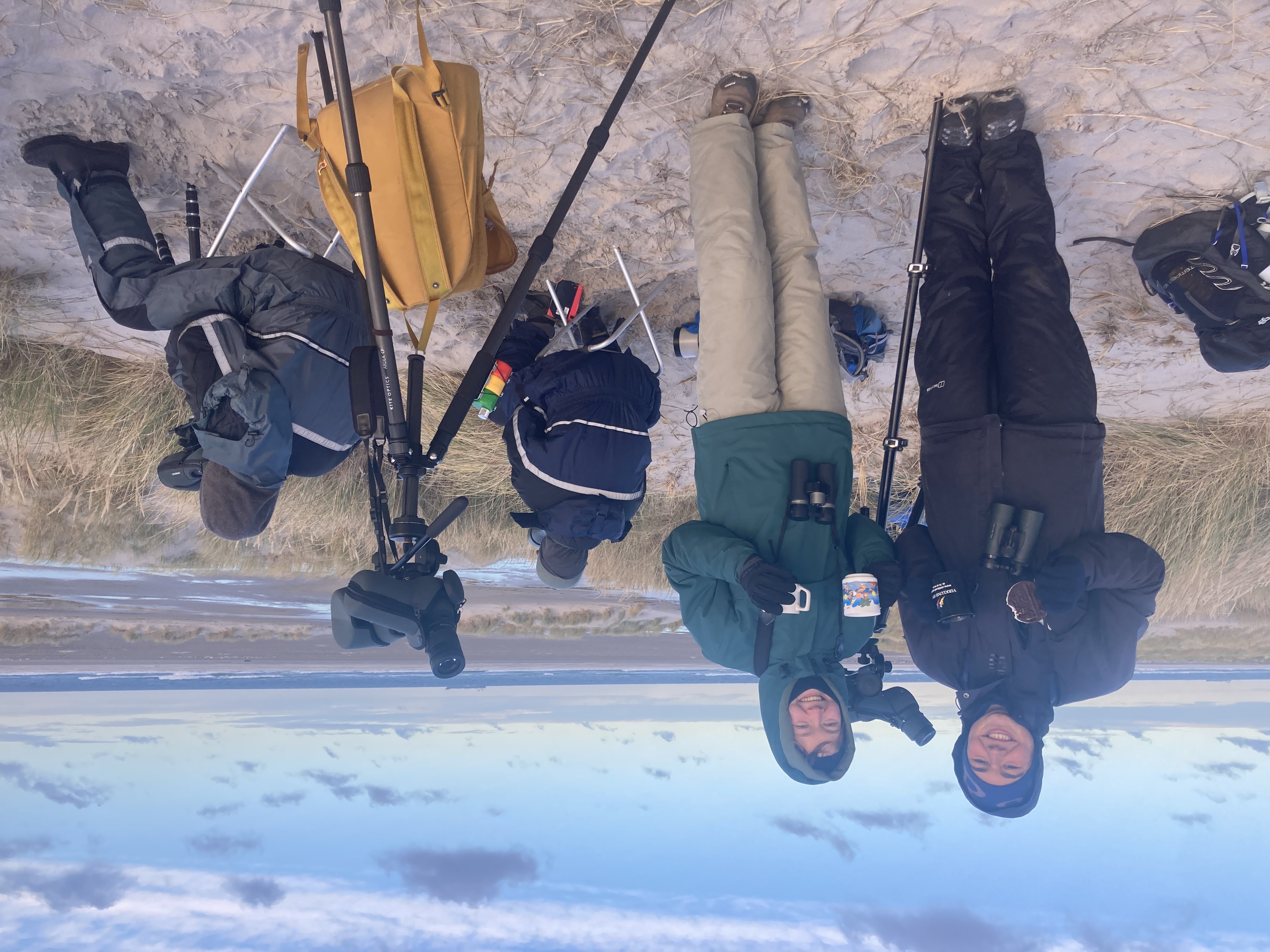
Even though the sun was shining brightly, I did find myself getting quite chilly as the morning went on, so I was quite jealous of the boiler suits that Florian and János were wearing today; they looked so cool and cosy. Maybe I’ll wear one next time because the forecast is predicting more cold weather on its way! However, the cold meant I was extremely grateful for the flask of coffee that Lise’s Dad brought along for us. Lise and I enjoyed a mug of coffee with our dark chocolate rice cakes whilst we stood on the sand dunes, which felt very luxurious indeed! It’s been great to spend time with Lise’s parents over the last few days and also thank you so much to them for gifting us 32 Flødebolle, which I’m sure will fill us with lots of energy and warmth for the next few days of observations and ringing!
In the afternoon, lots of birdwatching was done by everyone. Miles birded some of the patches around town and spotted a Woodcock (Skovsneppe) being flushed by a cat, a reminder of how deadly and dangerous outdoor cats can be to our native wildlife, especially birds! János visited the harbour for some “gulling” and, although he didn’t spot any rarities this time, he was rewarded with some epic views of a Red-throated Diver (Rødstrubet Lom), less than 10m away! Lise spotted a range of birds on her run and then enjoyed sunset up the lighthouse. Florian went birdwatching around the Nature Centre where he spotted two Chiffchaffs (Gransanger) and I bumped into him and we saw some nice Crested Tits (Topmejse) in the pine trees.

We both then headed to the beach for sunset but via different routes. I had a close encounter with a Polecat (ilder) by Cormorant Lake on my way which had a dead rodent in its mouth, and Florian saw a Goshawk as he cycled past Jennes Sø. For the third day in a row, the special Skagen light delivered an incredible sunset, full of pink, marshmallow-like clouds, glistening orange sea, and with plenty of Sanderling (Sandløber) scampering along the strandline, it was just perfection. Now, we're back at home and Lise is cooking us a delicious dinner which already smells delicious; I can't wait!

Link to today’s observations from the area.
People: Miles Scheuering, János Schadl, Florian Hatt, Amira Nuseibeh, Lise Mastrup, and our guests Birgit and Morten Mastrup.
Gode fugle og glade fuglekiggere trodsede kulden i dag
I nettene ved Kabeltromlen var vi i dag heldige at have flere arter, som vi ikke ringmærker hver dag. Heriblandt var en træløber (eurasian treecreeper), to unge gulspurve (yellowhammer) og genfangst af en stor flagspætte (great woodpecker). Sidstnævnte var en fugl fra i år, men allerede med helt sort hoved og nakke og dermed en hun.
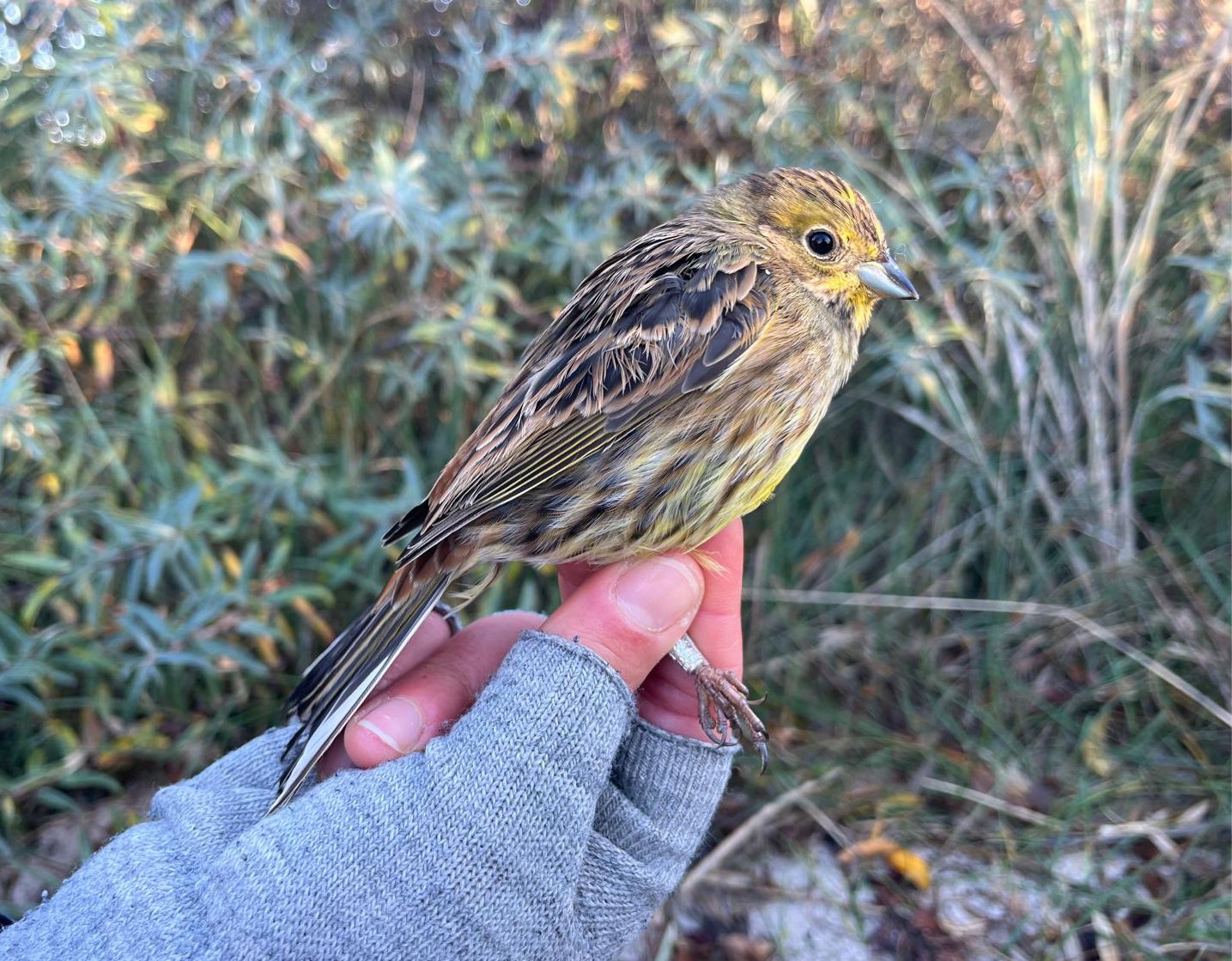
Gulspurv (Yellowhammer).
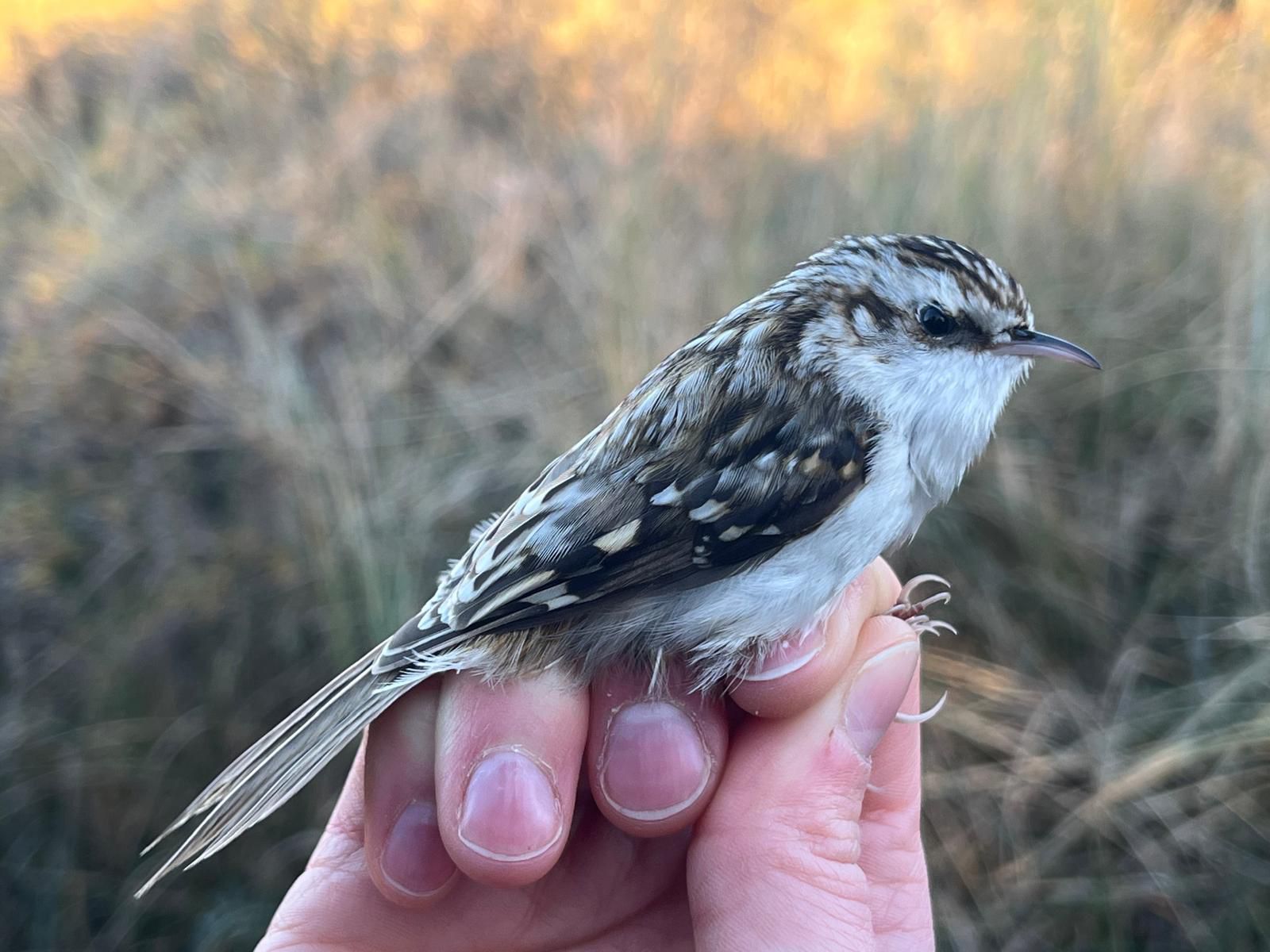 Dagens træløber (eurasian treecreeper).
Dagens træløber (eurasian treecreeper).
Miles og jeg (Lise) fik os desuden både en overraskelse, men også skuffelse da vi drejede om hjørnet til nogle af nettene i den nordlige del af netområdet. Her forskrækkede vi vist en dobbeltbekkasin (common snipe) som fløj op og lige ind i et af nettene. Vi satte begge straks i løb (så meget man nu kan i vand til knæene) for at nå hen til den. Lige så hurtigt den var fløjet ind, lige så hurtigt var den dog ude igen og væk over tagrørene.
En glædelig observation fra Kabeltromlen var til gengæld en flok på omkring 20 silkehaler (waxwings), som satte sig i nogle af træerne nær os, hvor vi tydeligt kunne se dem i både kikkert og skop! Amira hævdede endda at dette måske har været højdepunktet i hendes liv. Jeg krydser fingre for, at hun har mange mindst lige så fantastiske øjeblikke til gode, men det siger måske alligevel lidt om begejstringen, der var blandt os.
Vi mærkede klart, at i dag var koldere end tidligere. Både på vores tæer og vandet i rørskoven, som nogle steder var frosset over. Derfor gik vi runder og tjekkede net lidt oftere af hensyn til at fuglene ikke kommer til at hænge og fryse.
På Verdens Ende 3 var vores observatører, Florian og János, forberedte på det ekstra kolde vejr og trukket i flyverdragterne, som heldigvis holdte dem varme. Det blev til fire timers træktælling i smukt vejr og med en masse alke (razorbills) og rødstrubede lommer (red-throated divers). Ligesom i går så de også en masse sangsvaner (whooper swans). Sandsynligvis har det kolde vejr nu lokket dem til at trække sydpå fra Sverige og Norge af. Akkurat inden standardtiden sluttede dukkede en søkonge (little auk) op, som landede et par minutter og blev set godt.
Efter frokost tog János og Florian sammen på tur, først til krattet ved Stald Grenen for at tjekke om himalayasangeren (hume’s leaf warbler) måske stadig var at finde, men ak, det er nu anden dag i træk den ikke er genfundet. Måske den er taget videre. Herefter cyklede de videre til Nordstrand for at fotografere sandløberne (sanderlings), hvor også Amira slog sig til dem.
Folk på stationen: Miles Scheuering, János Schadl, Florian Hatt, Amira Nuseibeh, Lise Mastrup & vores gæster Birgit og Morten Mastrup
Temperatures are dropping
Finally, the weather forcast predicted some sun after a lot of rain and clouds in the last few days. However, due to the cloudless night, it was also significantly colder, and at least for János, a warm boilersuit finally made its debut for the season. In general, there was significantly more going on than in recent days. At least the pages in my notebook filled up much faster than usual. Right at the start, Knud said that we would see lots of swans today after the drop in temperature. And he was absolutely right. Small groups of Whooper Swans (Sangsvane) arrived constantly and some were calling and flying directly overhead. For me, this counts definitely also as a highlight - I just love hearing their calls and seeing them so close. Another real highlight was the Richard's Pipit (Storpiber) that Janos heard. Unfortunately, after the first call, which only he heard, a military jet roared in, so we had no chance of hearing any other calls.
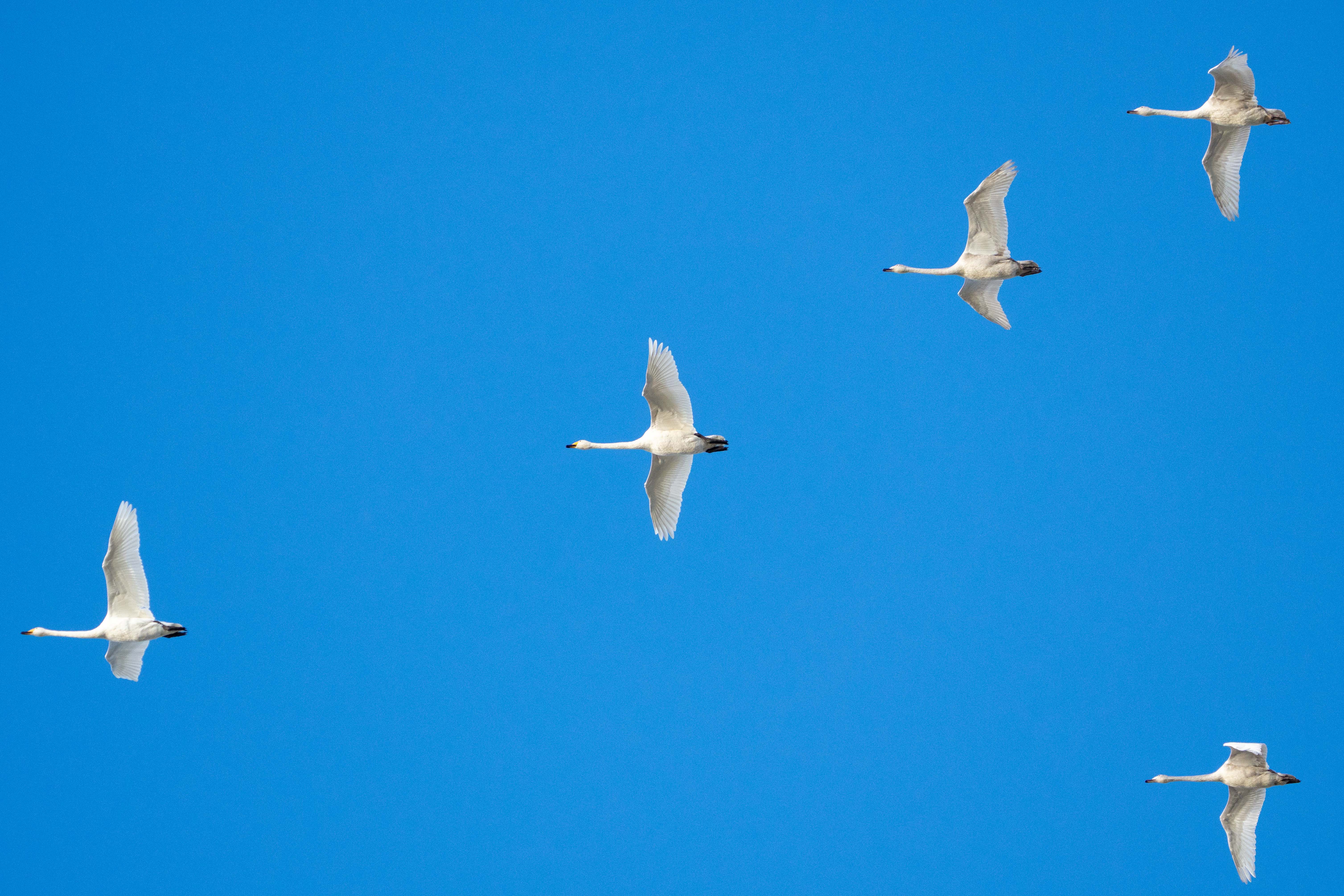
Whooper Swans (Sangsvane) flying overhead
And János had also a new lifer today – a Little Auk (Søkonge)! It was great to see one again, after they had become more scarce over the last two weeks. It was also funny to see a woodcock arriving from the sea. A short-eared owl out at sea was another highlight – it was again a really nice migration count!
At the ringing site was also more activity than the last time we had the nets open. The highlight was a new, unringed firecrest that flew into the nets. Also, seeing a fieldfare up close is always a fantastic experience! 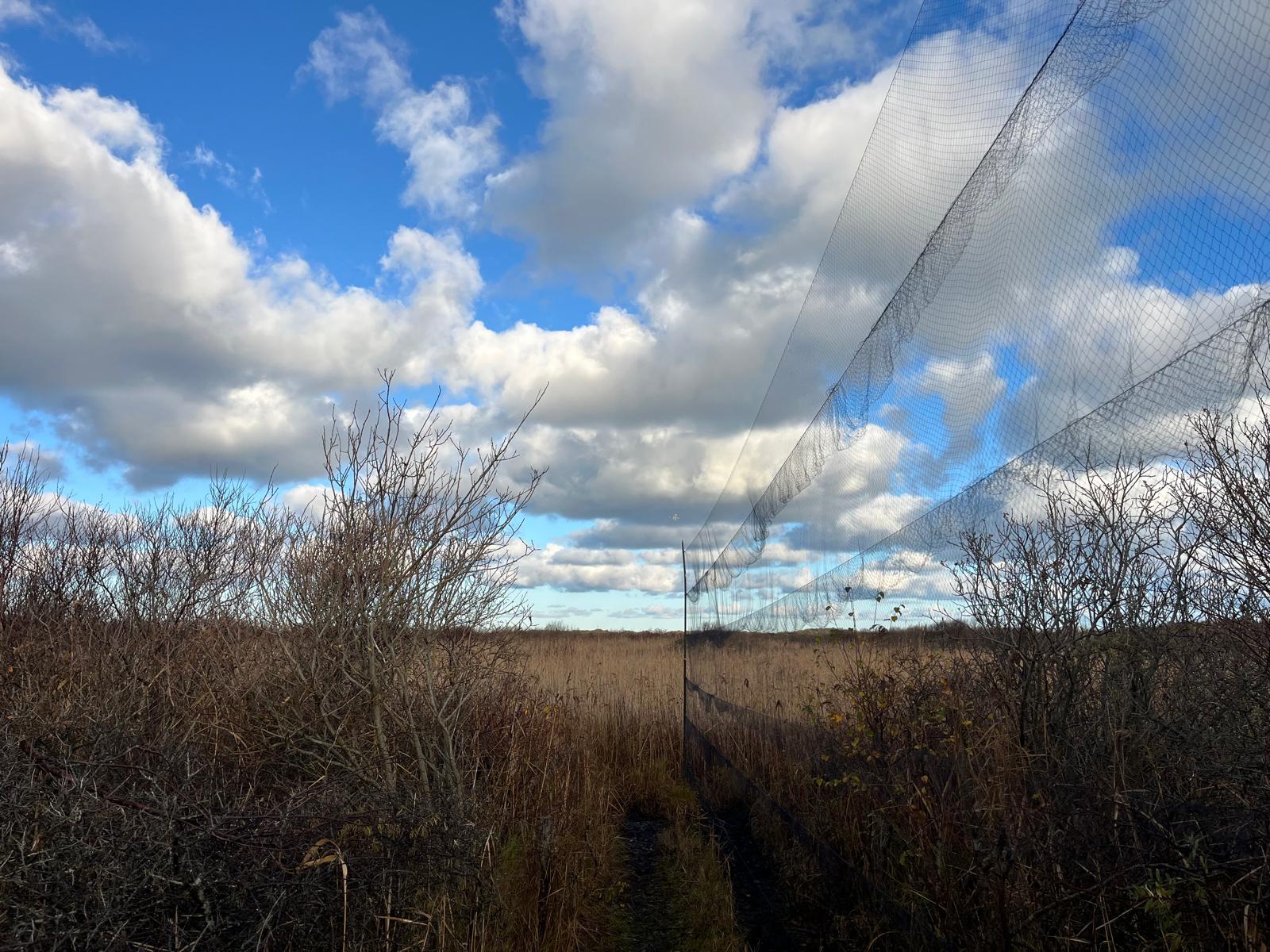
Find the military jet flying over the nets ;)
After the migration count I stayed outside and searched a bit for the Richard’s Pipit (Storpiber) and, as always, for rare buntings (sjældne værlinger). Once again I was without success. The best sight was probably a small flock of Water Pipits (Bjergpiber) resting in one of the reed beds.
The others also took advantage of the beautiful weather in the afternoon. János visited the Hume’s Leaf Warbler (Himalayasanger) spot, but only the known Siberian Chiffchaff (Sibirisk Gransanger) was there. However, it was nice that it was really easy to see today. Amira went on a walk to the beach, where we bumped into each other. We were both looking for Snow Buntings (Snespurv) because a flock had been flying around before, but it had just disappeared. The evening sun was really nice, so I hoped to get a few pictures. Instead of Snow Buntings (Snespurv), however, I found some Sanderlings (Sandløber), which were also very photogenic, so I spent some time with them.
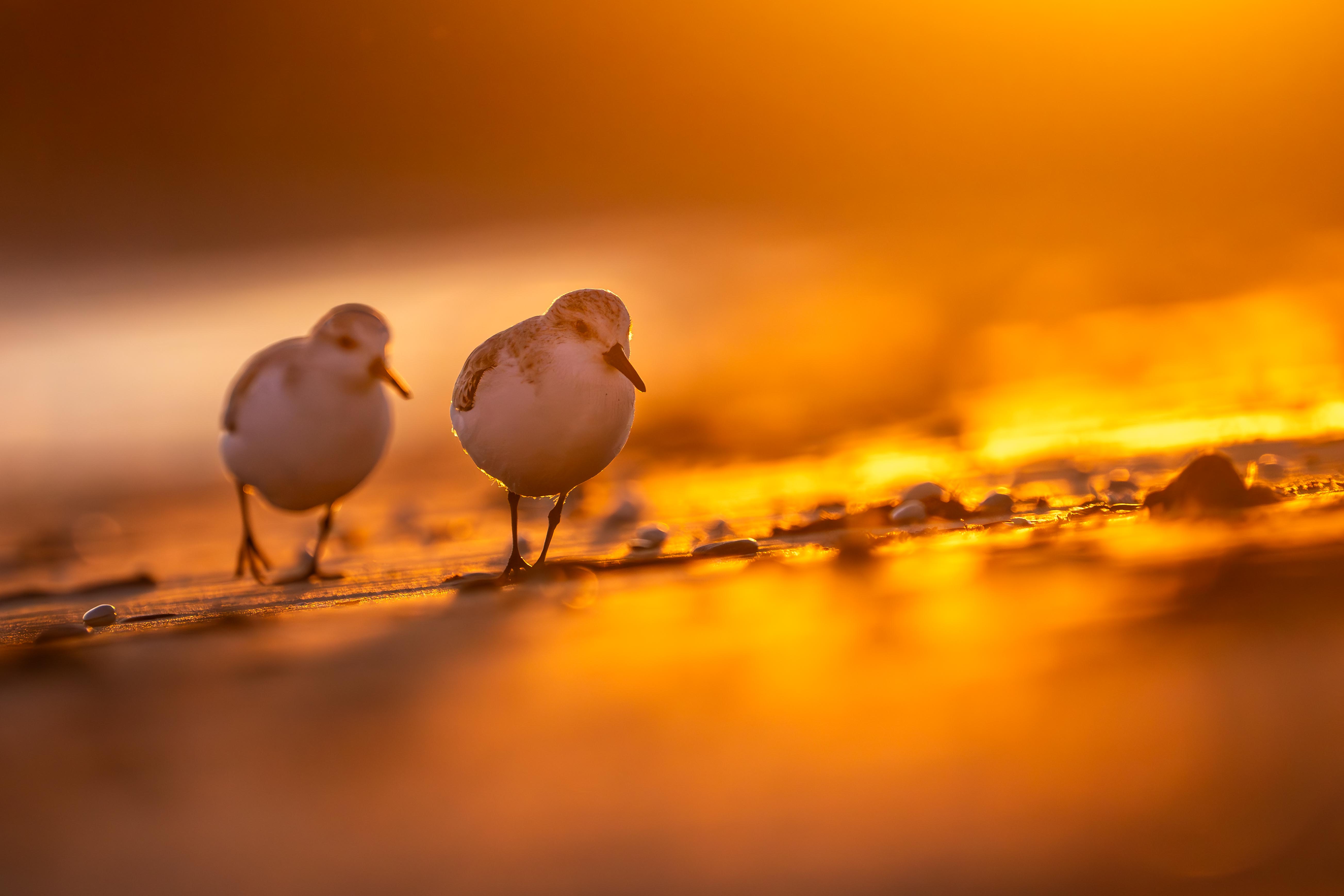
Sanderlings (Sandløber) in the evening sun
When they were once again flushed by some German tourists and flew towards me, there was also another bird. At first I wondered what kind of fat wader was coming towards me, until I realised it was a Little Auk (Søkonge)! Luckily, I already had the right camera settings when this tiny auk flew past me on the beach. What a nice surprise!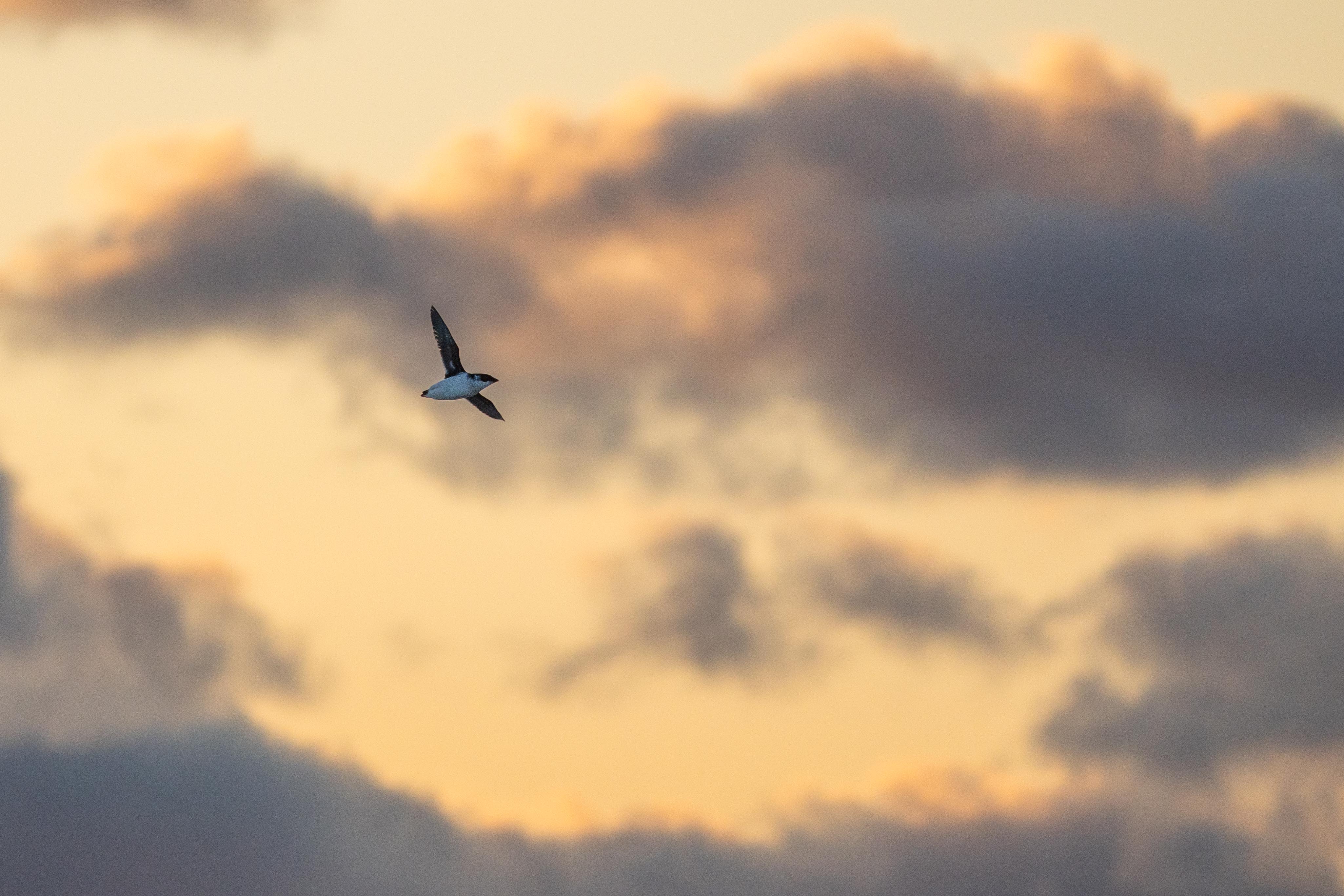
Little Auk (Søkonge)
After a long day outdoors, I returned home with some good photos and even better observations! To round off the day perfectly, János cooked us a delicious dinner!
Ringing (Kabeltromlen)
Solsort 5
Sjagger 1
Grønsisken 1
Gærdesmutte 3
Rødhals 2
Blåmejse 16
Dompap, Stor 3
Dompap, Lille 2
Dompap 1
Munk 1
Bogfinke 4
Gransanger 1
Rødtoppet Fuglekonge 1
Fuglekonge 3
Total: 44
Ringing (Jennes Sø)
Blåmejse 19
Halemejse, Nordlig (ssp. caudatus) 2
Gransanger 1
Fuglekonge 2
Solsort 1
Rødhals 1
Gråsisken, Lille (ssp. cabaret) 1
Grønsisken 1
Total: 28
Søkonge 2
Link to today’s observations from the area
People: Miles Scheuering, János Schadl, Florian Hatt, Amira Nuseibeh, Simon S. Christiansen
Bad weather – good Birds
Today was a rainy day, and even though the forecast told us that it would stop raining in half an hour every time we checked it, it continued pretty much all day. We got up as usual, and since the weather was definitely not good enough for ringing, we waited a bit for the rain to stop and at some point decided to do the migration count despite the adverse conditions. Packed in several layers of warm clothing and waterproofed with a rain jacked, rain pants and rubber boots, we where well equipped and Florian, Amira and I arrived only 20min after sunnrise at Grenen.
Next to many Red-throated Divers (Rødstrubet Lom), our first highlight of the day was a Great Northern Diver (Islom) only five minutes after the start of the count. Later followed by a Yellow-billed and a Black-throated Diver (Sortstrubet Lom), this was the first time in this autumn season that we managed to see all four european Diver species in one morning! It was very nice to be able to see and compare all of them in such a short time span, and the Yellow-billed Diver (Hvidæbbet Lom) was a lifer for me. Later we also got very good views of a resting Great Skua (Storkjove) before we gave in to the rain and went back after 2,5 hours of counting.

Florian and János during the count. Photo by Amira
While we were counting, Miles had a quiet morning, updating the picture archive and baking a delicious „Pallid Swift Cake“ for us in remembrance of the Pallid Swift (Gråsejler) that was in the area for the past few days and often came surprisingly close, giving good views.
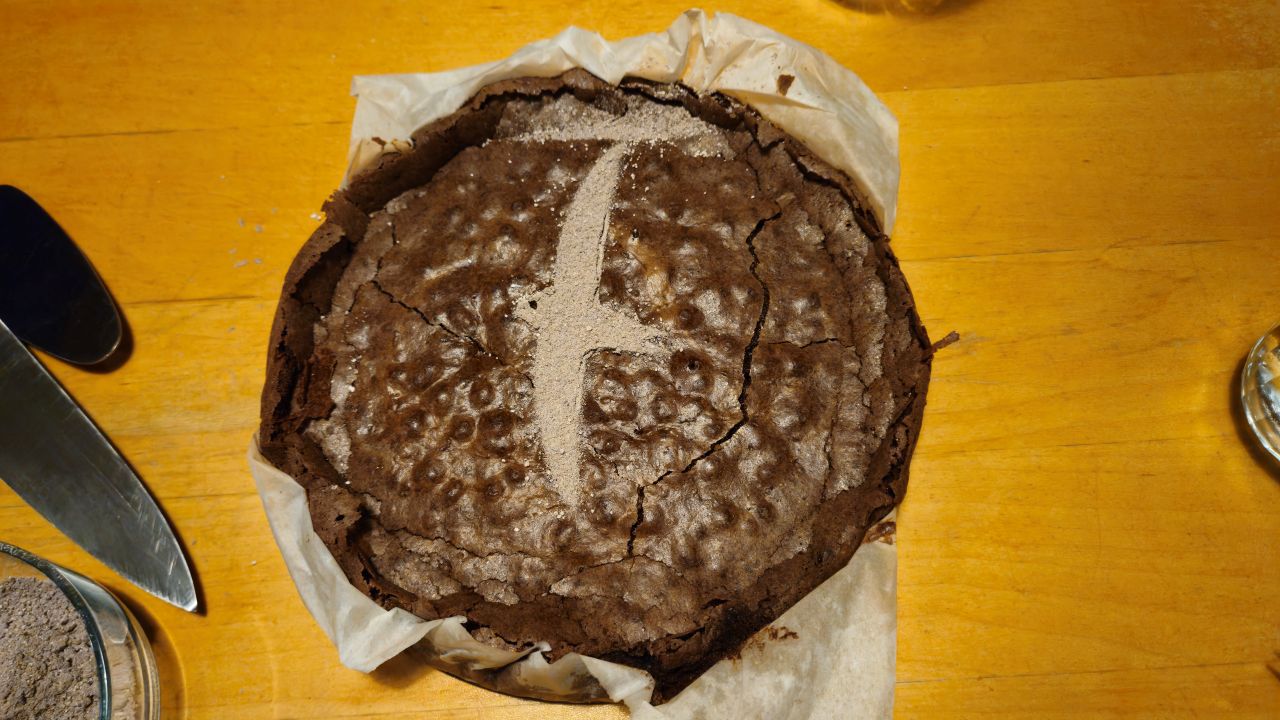
Miles Pallid Swift Cake. Photo by János
After we came back, we had lunch and I had a restful afternoon. Miles went for a run, and then he, Amira and Florian went for a swim, spotting a remarkably late House Martin (Bysvale). Later, Florian left for the grocery store to buy food for dinner, and Amira climbed the lighthouse tower to use the good acoustics there and played her recorder (instrument). In the afternoon the skagen fuglestation hoodies we had designed and ordered finally arrived, and they turned out very well!
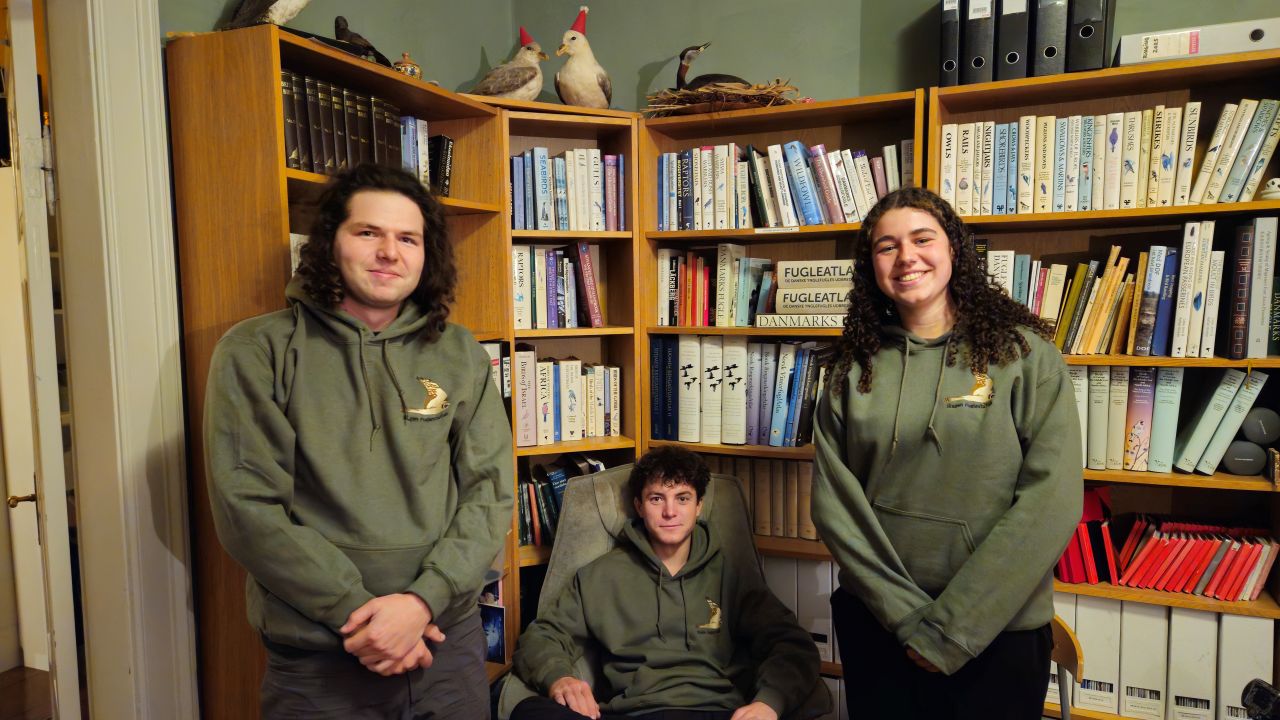
Miles, Florian and Amira wearing the new Hoodies. Photo by János
No ringing today due to the rain
Highlights from today’s observations:
Great Northern Diver (Islom) 1
Black-throated Diver (Sortstrubet Lom) 1
Yellow-billed Diver (Hvidæbbet Lom) 1
Great Skua (Storkjove) 1
House Martin (Bysvale) 1
Link to today’s observations from the area
People: Miles Scheuering, János Schadl, Florian Hatt, Amira Nuseibeh
Restful rainy day
This morning it was too windy to ring, but we had hoped that the migration count would still be possible. Unfortunately, it was quite rainy and starting too early to allow us to complete any of the count. That meant we had a chill morning, and we were able to catch up data tasks, like entering/checking data and updating the picture archive. Amira was able to visit the pool in town for some lap swimming and was pleasantly surprised to find it completely empty. Lise is away for a few days, leaving just four of us at station, and it feels quite quiet. She is visiting Blåvand Fuglestation and we wish her a good trip but look forward to her return!
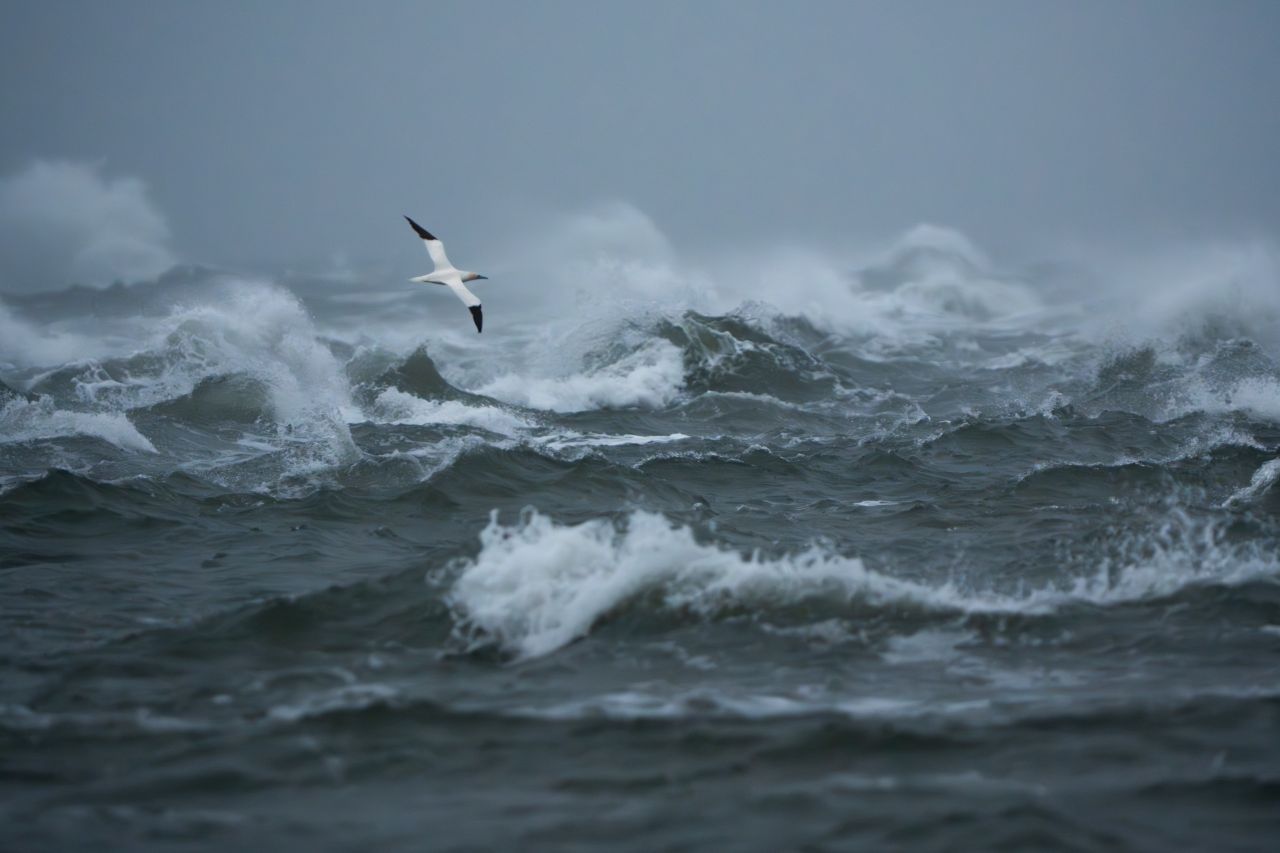
Northern Gannet (Sule) flying amongst waves at the tip of Grenen. Photo by Florian
The rain let up a bit in the afternoon, and we were all able to get out for a bit. Florian and János went out to Grenen and did some birding and photography at the tip. The waves were quite dramatic because of the stormy weather, and it created great conditions for photographing the Northern Gannets (Sule). There were also Black-legged Kittiwakes (Ride) flying quite close and providing good views. Afterward, they collected the recorder János placed near Kabeltromlen and moved it to the Hume’s Leaf Warbler (Himalaya-sanger) patch at Stald Grenen with the hope of getting some good recordings. Knud was out searching for the Hume’s in the afternoon and did not see it but did see the Siberian Chiffchaff (Sibirisk Gransanger) again. Amira did a ton of work entering and checking data sheets today but got out for a walk in the afternoon. Even though it was drizzly, it was still pleasant to be out, and she enjoyed seeing several Snow Buntings (Snespurv) on the beach. I also enjoyed getting out for a short run as darkness started to settle.
This evening, Amira cooked us a spicy Middle Eastern stew. It was delicious! Mara had a low spice tolerance, and after dinner today, János commented that almost every meal since she left has been spicy. Likewise, there was a surge in dishes with coconut after Sarah, who did not like it, left.
Now, Amira and János have gone out night catching. We still hope to catch a Snow Bunting or maybe even a Shore Lark aka Horned Lark (Bjerglærke). They are quite flighty and eluded us thus far this fall.
No ringing today
Link to today’s observations from the area
People: Miles Scheuering, János Schadl, Florian Hatt, Amira Nuseibeh, and Simon S. Christiansen.
A Terrific Team Twitch
It was windier than expected as Lise, Florian and I headed out to ring at Kabeltromlen this morning, and so we decided not to open some of the more exposed nets. This did mean we had much fewer birds than usual but amongst them some gems in the shape of two Firecrest (Rødtoppet Fuglekonge). One of the two Firecrests was a bird ringed here almost exactly a year ago on the 8th November 2024, so it’s exciting to see it has survived a full year!
Because we had such few birds we had time to appreciate each one, including a beautiful Song Thrush (Sangdrossel) with its characteristic upside-down heart-shaped dark markings on the breast. We also did some observing between net-checking rounds and heard an interesting call from one individual bird flying over amongst a flock of Common Crossbill (Lille Kornsnæb). Luckily, Florian had his recorder on him so we'll try to figure out what the mystery bird might be by inspecting the spectrogram later. Eventually, the wind became too strong and cold, so we closed the nets and retreated back home again for some well-earned lunch and some delicious leftover coconut chocolate cake baked by Lise.
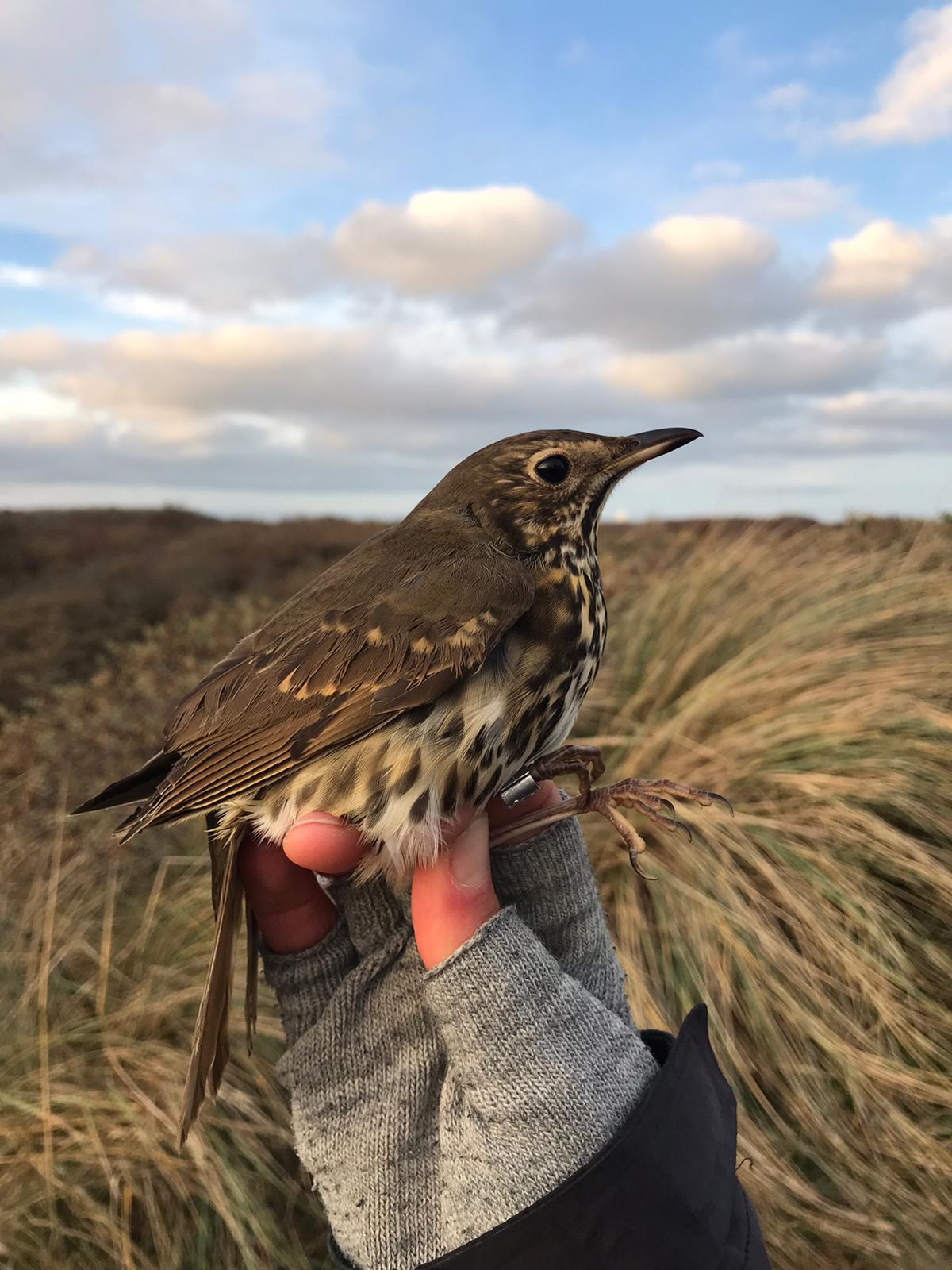
The observers, Miles and János, were kept busy this morning at World’s End 3 with just the two of them there, but they thoroughly enjoyed it. The best bird was definitely a Sooty Shearwater (Sodfarvet skråpe) spotted by Miles, which was quite close by and flew back and forth, even briefly resting on the water; a really cool observation! They also saw two stunning Shorelarks (Bjerglærke) hopping around on the beach, as well as a lovely diversity of other species including Black Throated Diver (Sortstrubet Lom) and Black Guillemot (Tejst).

Then, we were all determined to try and see the Hume’s Leaf Warbler (Himalayasanger) so we cycled to the spot where Florian had first heard it calling at sunset yesterday. Almost immediately we all spotted it darting aroundin the bushes, showing extremely well and calling nicely and regularly too. Listen to it here:
It was a lifer for Miles, Lise and I, and even Simon said it was the best Hume’s Warbler he’s ever seen!
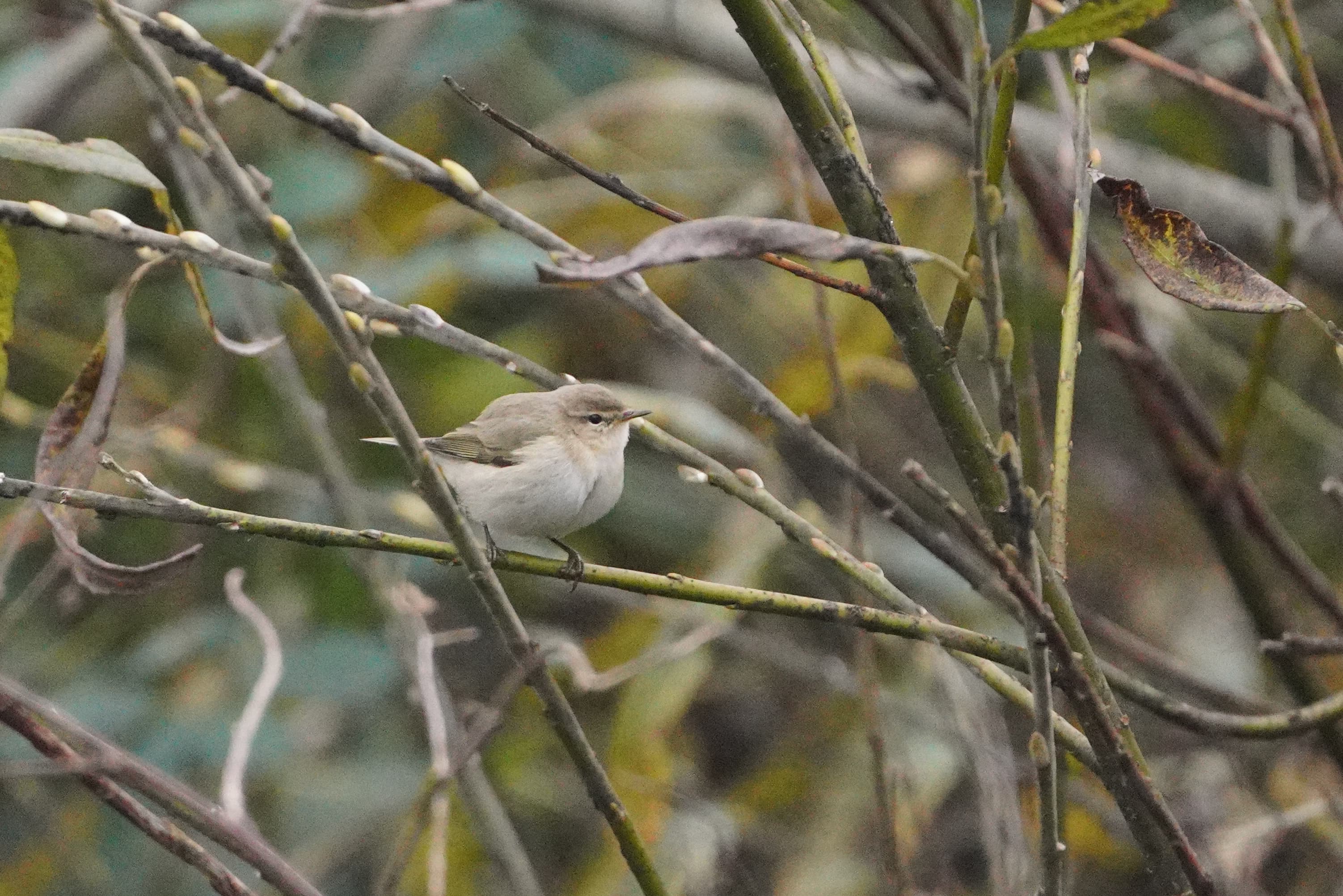
As we stood admiring it, János also spotted a Siberian Chiffchaff (Sibirisk Gransanger) in the same bush; what are the chances! That now means we’ve had a Dusky Warbler (Brøn Lovsanger), Hume’s Leaf Warbler and a Siberian Chiffchaff all within 1km and 24hrs of each other!
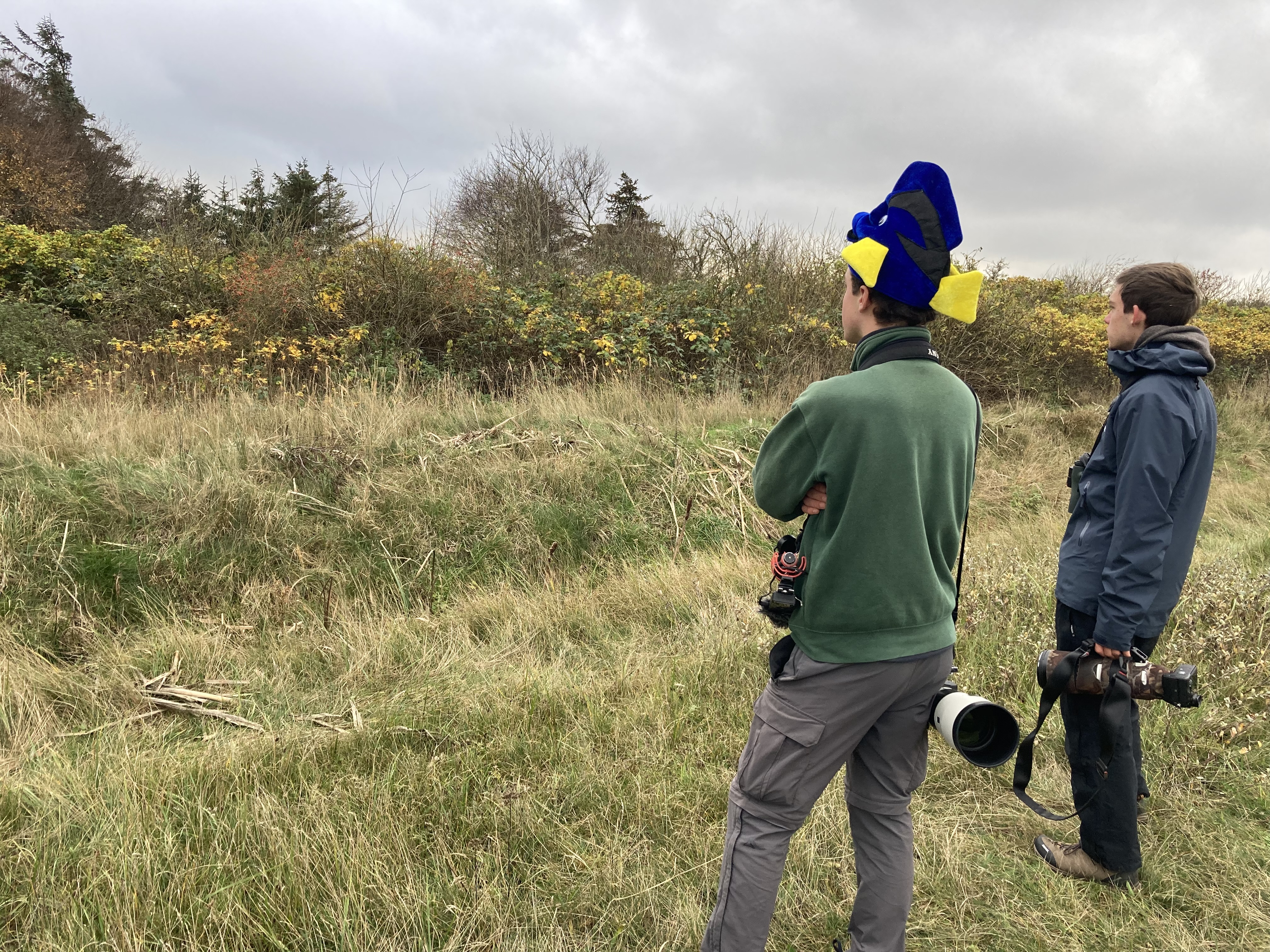
Afterwards, János and Florian continued birdwatching and found lots of Bearded Reedlings (Skægmejse) calling around cormorant lake and surprisingly many chiffchaffs about which is nice for this time of year. Meanwhile, Miles and Lise headed to the shops in town, and Simon was in a Bird Observatory board meeting all day, but did manage some birdwatching beforehand of course. Overall, it was another absolutely terrific day, full of twitches, tasty treats and top birds!
Link to today’s observations from the area
People: Miles Scheuering, Lise Mastrup, János Schadl, Florian Hatt, Amira Nuseibeh, and Simon S. Christiansen.
Sangere for både observatører og ringmærkere
På Verdens Ende 3 udgjorde Florian, Miles og János holdet til morgenobservation. János var tidligt af sted for at sikre gode pladser. Forholdene var lignende i går, dog mindre blæsende og derfor ikke så koldt, hvilket blev værdsat. Igen i dag kom en islom (great northern diver) forbi. Disse er efterhånden blevet faste gæster ved Grenen, men ikke desto mindre blev den værdsat. Især da den blev hængende lidt og rastede, så der var god mulighed for at se den. Det blev nævnt, at der måske ville dukke nogle sejlere op. Ikke længe efter spottede Miles netop en og råbte straks op. Det viste sig at være en gråsejler (pallid swift). Måske samme individ som har befundet sig i området de sidste flere dage? I hvert fald fløj den lige over hovedet på observatørerne, som også fik gode billeder af den. Andre bemærkelsesværdige fugle fra observationen var storspove (curlew), strandskader (oystercatchers), sortgrå ryle (purple sandpiper) og stenvendere (turnstones). Om end ikke ligefrem sjældne, var det alligevel nogle der blev sat pris på herude.
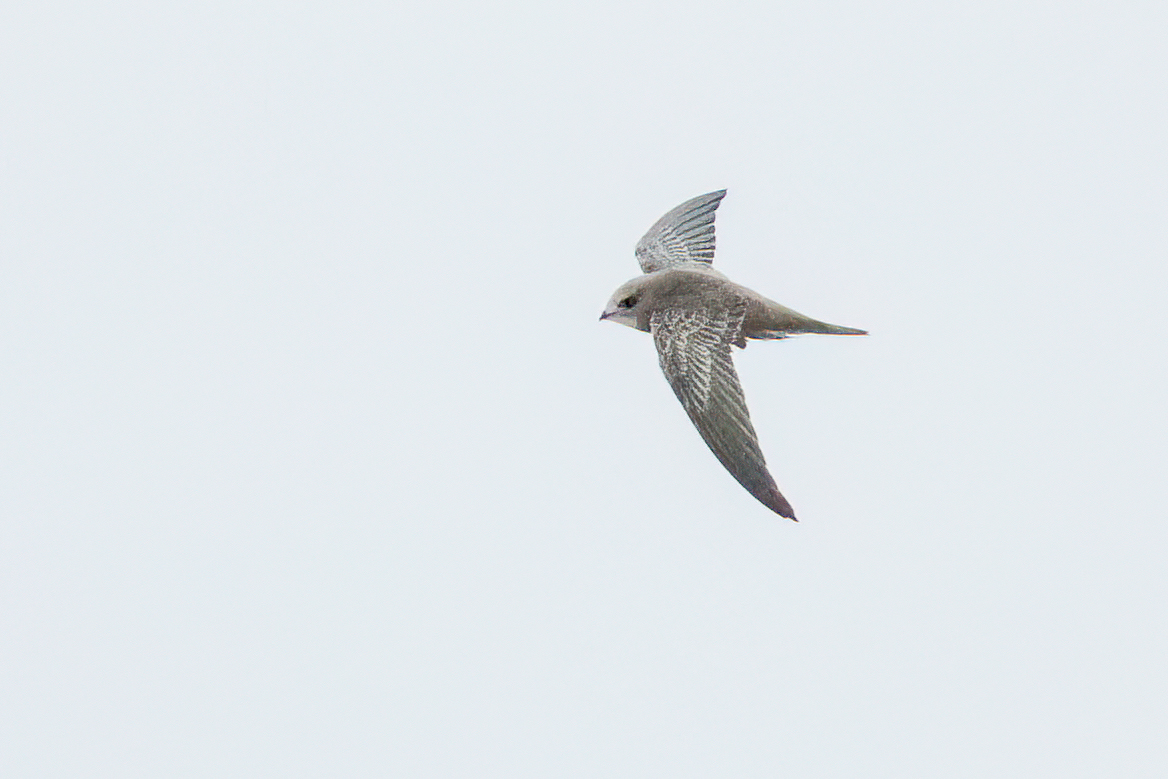
Gråsejler (Pallid Swift). Foto af Florian Hatt.
Ved Kabeltromlen så Amira og jeg (Lise) endda også gråsejleren (pallid swift) da den blev kaldt ud fra Verdens Ende 3. Med hensyn til ringmærkning havde en rolig, men ikke kedelig dag. Der var et fint antal fugle i nettene til at holde os beskæftigede og heldigvis god tid til dem også. Vi havde både genfangster og nye mærkninger af skægmejser (bearded reedling), som jeg på daværende tidspunkt tænkte ville være dagens højdepunkt. Sidst på formiddagen dukkede der dog en gransanger op, som muligvis kunne være en sibirisk gransanger (siberian chiffchaff). Forskellene mellem en almindelig gransanger og den sibiriske underart er subtile, men farven på eksemplaret fra i dag var mindre grønlig, gullig og snarere mere brunlig, hvilket ledte tankerne hen på, at det kunne være en sibirisk. Efter ringmærkning og fotografering fik vi bekræftet fra Simon, at det var tilfældet.
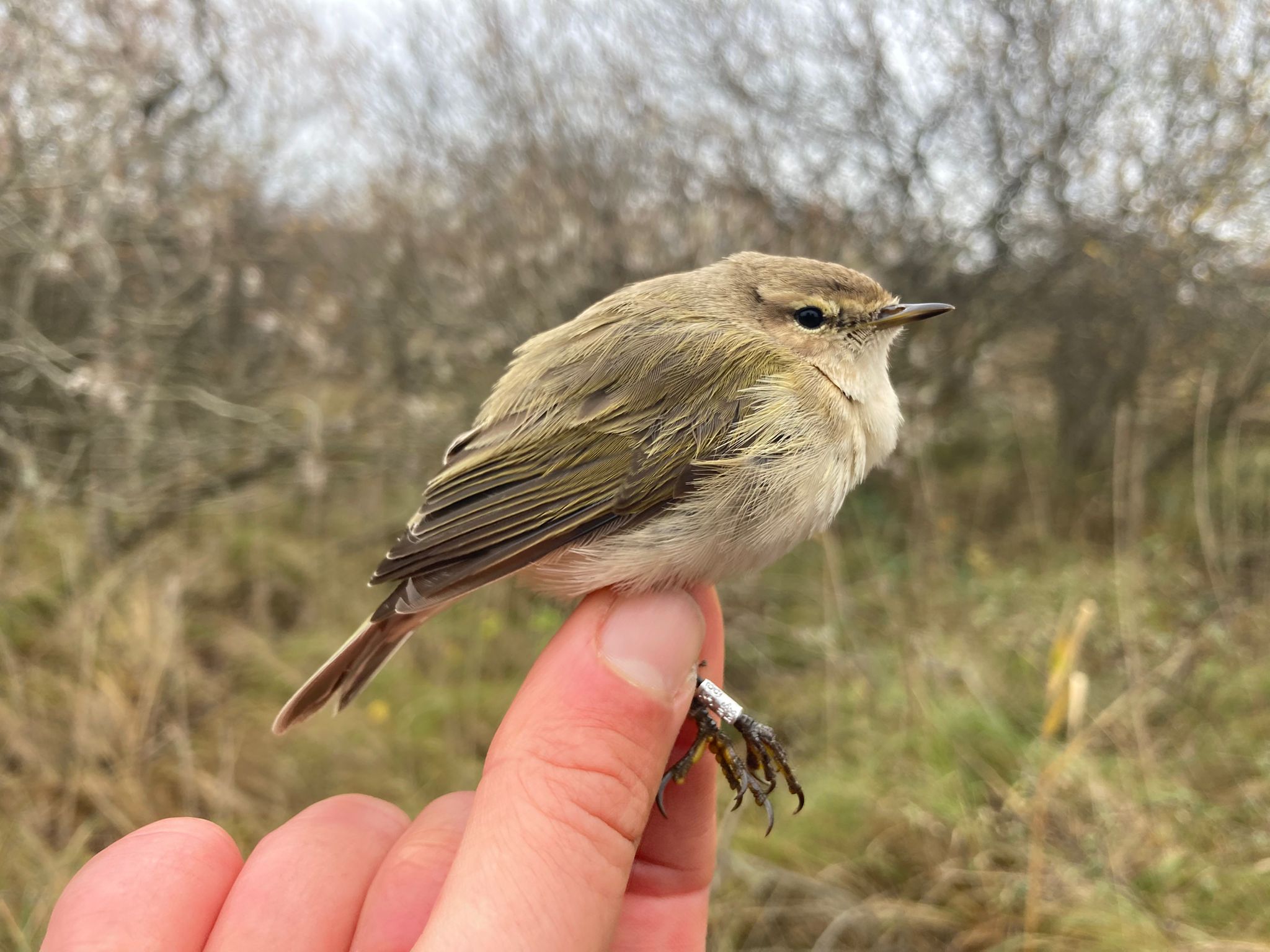 Sibirisk Gransanger (Siberian Chiffchaff). Foto af Amira Nusibeh.
Sibirisk Gransanger (Siberian Chiffchaff). Foto af Amira Nusibeh.
Senere gik vi afsted på lukkerunden tilfredse med dagens ringmærkning. Her ventede der os en sidste overraskelse. Nemlig en vandrikse (water rail), som Amira begejstret pillede ud af nettet. Vi hører vandrikse hver dag ude i rørskoven, men det er kun anden gang på denne efterårssæson, at en af dem går i nettet. Denne gang var det en ung fugl i sit første kalenderår, hvilket blandt andet kan genkendes på den mørke overside af næbet og de endnu ikke helt skarpe hvide streger på flankerne.
 Vandrikse (Water Rail). Foto af Miles Scheuering.
Vandrikse (Water Rail). Foto af Miles Scheuering.
I dag var desuden Amiras første som ringmærker med C-licens - tillykke! Og det endda på fornemmeste manér med smukt overblik og omhyggelighed.
Om eftermiddagen var Florian taget på fugletur i området nær stationen. Herfra kom et opkald fra ham om en mulig himalayasanger (Hume’s leaf warbler), som han længe har haft håb om at finde her. Det lykkedes ham at få lydoptagelser af fuglen, som herhjemme kunne bevise, at det minsandten også var en himalayasanger der var tale om! Det er kun fjerde fund for Skagen, så vi kunne fejre både denne og alle de andre skønne fugle fra i dag med kage hjemme på stationen.
Sidste nyhed herfra må være, at vi har fået besked om ringmærkningen af en skægmejse (bearded reedling), som blev genfanget ved Kabeltromlen den 27. oktober. Denne blev oprindeligt ringmærket ved Tømmerby Fjord i Thy den 5. juni i år, hvor der findes en ynglende koloni af skægmejser.
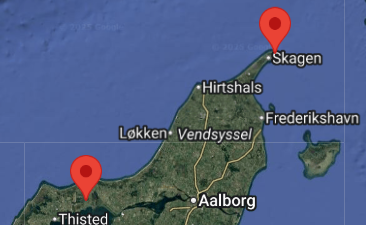
Kort med markering af lokaliteterne for henholdvis ringmærkning nederst til venstre og genfangst øverst til højre af skægmejse (bearded reedling).
Vandrikse 1
Sangdrossel 1
Solsort 3
Gærdesmutte 5
Rødhals 7
Skægmejse 1
Munk 3
Blåmejse 8
Dompap 1
Fuglekonge 7
I alt: 38
